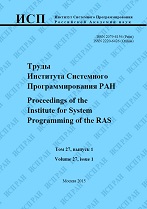|
This article is cited in 1 scientific paper (total in 1 paper)
An approach to test program generation based on formal specifications of caching and address translation mechanisms
A. Kamkin, A. Protsenko, A. Tatarnikov
Institute for System Programming of the Russian Academy of Sciences
Abstract:
A memory subsystem is one of the key components of a microprocessors. It consists of a number of storage devices (instruction buffers, address translation buffers, multilevel cache memory, main memory, and others) organized into a complex hierarchical structure. Huge state space of a memory subsystem makes its functional verification extremely labor consuming. Nowadays, the main approach to functional verification of microprocessors at a system level is simulation with the use of automatically generated test programs. In this paper, a method for generating test programs for functional verification of microprocessors’ memory management units is proposed. The approach is based on formal specification of memory access instructions, namely load and store instructions, and formal specification of memory devices, such as cache units and address translation buffers. The use of formal specifications allows automating development of test program generators and makes functional verification systematic due to clear definition of testing goals. In the suggested approach, test programs are constructed by using combinatorial techniques, which means that stimuli (sequences of loads and stores) are created by enumerating all feasible combinations of instructions, situations (instruction execution paths) and dependencies (sets of conflicts between instructions). It is of importance that test situations and dependencies are automatically extracted from the formal specifications. The approach was used in several industrial projects on verification of MIPS microprocessors and allowed to discover critical bugs in the memory management mechanisms.
Keywords:
microprocessors, memory management, caching, address translation, functional verification, formal specifications, test program generation, instruction stream generation.
Citation:
A. Kamkin, A. Protsenko, A. Tatarnikov, “An approach to test program generation based on formal specifications of caching and address translation mechanisms”, Proceedings of ISP RAS, 27:3 (2015), 125–138
Linking options:
https://www.mathnet.ru/eng/tisp141 https://www.mathnet.ru/eng/tisp/v27/i3/p125
|

| Statistics & downloads: |
| Abstract page: | 114 | | Full-text PDF : | 69 | | References: | 22 |
|




 Contact us:
Contact us: Terms of Use
Terms of Use
 Registration to the website
Registration to the website Logotypes
Logotypes








 Citation in format
Citation in format 
